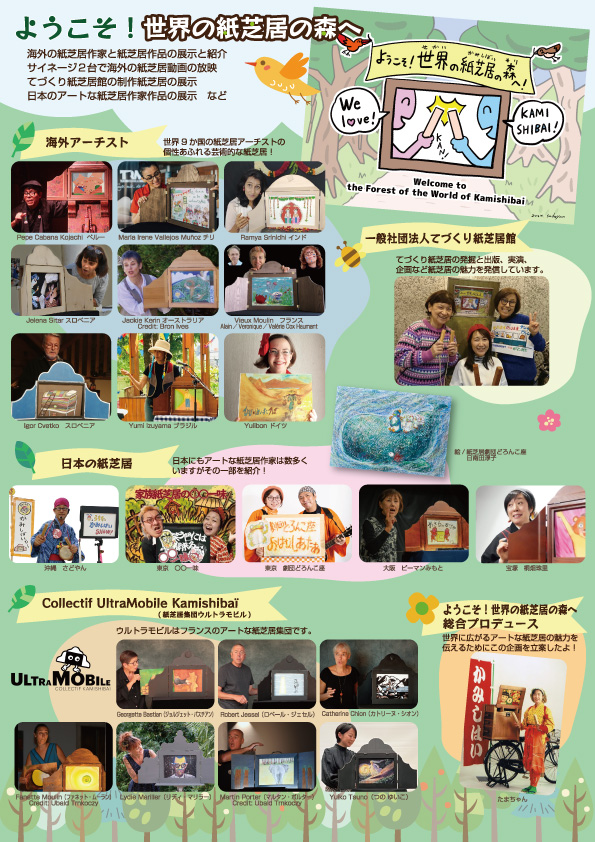As promised, this blogpost is a continuation of the last, where I provided a synopsis of a discussion among four influential voices in the world of kamishibai in Japan, moderated by the head of the Children’s Cultural Research Center in Tokyo, Suzuki Takako. In the beginning of their conversation, they looked back at the history of kamishibai and the various challenges it has faced, and in the second half, their discussion shifts to new directions in kamishibai’s future.
I should preface this synopsis of their discussion by pointing out that the people involved are, for the most part, the older guard of the kamishibai world today. Sakai Kyōko, Nagano Hideko, and Miyazaki Fumie all range in age from 70 to 80, and the youngest member of the group, Tsukahara is probably 40-50 years old. This is important to understand because the tensions that arise in this conversation amongst the participants come out of their greater or lesser ability to imagine definitions of kamishibai changing or expanding going forward.
Perhaps the most fearful for kamishibai’s future is, in fact, the youngest member, Tsukahara, who wonders if kamishibai will even be around by 2030, its centennial year. He argues that unless there is more effort put into nurturing a younger generation of kamishibai enthusiasts in Japan, kamishibai’s future in its country of origin is pretty dire. But how, he asks, is the younger generation going to be inspired to engage in kamishibai when there are so many other distractions from social media, the internet, and now AI? Interestingly, Tsukahara used ChatGPT to ask the question: What is the future of kamishibai? I will translate ChatGPT’s answer to his question later in this post.
The one who is by far the strictest about her definition of kamishibai is Sakai Kyōko, president of Dōshinsha and representative of IKAJA (the International Kamishibai Association of Japan). She adheres strongly to IKAJA’s view that kamishibai should not involve “performance.” IKAJA believes that kamishibai should be a pure instrument for creating a sense of kyōkan (shared feeling), and the most effective way to do this is to tell only the most superior kamishibai stories in a way that lets the author’s work speak for itself. She argues that carefully selected kamishibai, created by professional authors and published at Dōshinsha’s high quality standards, will lead audiences toward a feeling of kyōkan and ultimately to world peace. This pure message can only be achieved, according to IKAJA, if the performer does not draw attention to themselves through over dramatization or flamboyant performance techniques. To ensure that people know how to select the most superior kamishibai, Doshinsha advertises its “best selections” and regularly publishes its recommendations.
The drawback with Sakai’s adherence to this strict definition of kamishibai is that it does not leave any room for the origins of kamishibai in the gaito street-performances of the past nor for the tezukuri “hand-made” kamishibai movement, which has taken off in recent years. After all, no one was vetting the street performance artists stories for the purity of their messages, and many of the stories were considered lurid and sensationalistic by the standards of educators and parents at the time. Much to the dismay of everyone involved in this discussion, the tezukuri kamishibai movement is comprised mostly of amateurs telling their own stories in as flamboyant a way as they see fit. Increasingly, people are even performing their own tezukuri kamishibai on YouTube and social media. Everyone involved in this discussion conceded a danger of kamishibai becoming only about flashy performances (派手なパーフォマンス) designed to draw attention to oneself instead of focusing on the integrity of the kamishibai format.
But Miyazaki, Nagano, and Tsukahara all argue in different ways that the tezukuri “hand-made” kamishibai movement is vital for nurturing a new generation of Japanese people who will grow up knowing what kamishibai is. As they point out, trying to make one’s own kamishibai story is a challenge that encourages a greater understanding of the format, and both Miyazaki and Nagano, who work with children creating their own kamishibai stories, understand the educational benefits of “active learning” in a wholistic way that kamishibai offers. Nagano, in particular, argues that it takes time to develop a true understanding of kamishibai, and that people who are new to the format need to be encouraged, not criticized, from the start.
The new directions for kamishibai that they discuss range from the giant kamishibai performances set to music by Morohashi Seikō (see his World Kamishibai Forum video), to IKAJA’s spreading of kamishibai to countries outside Japan, to kamishibai in senior facilities and care centers, and finally to kamishibai and AI. Surprisingly, the shortest section of the discussion focuses on IKAJA’s work in other countries. Sakai explains how she does not go to other countries to do kamishibai “performances,” but rather offers seminars to teach how to use kamishibai according to IKAJA’s methods. In some countries, such as France and Germany, she says a real understanding of kamishibai is taking root. Since Morohashi-sensei’s giant kamishibai performances, kamishibai for the elderly, and other initiatives with kamishibai in Japan are treated in more depth in later articles in this special issue, I will save discussion of them for later.
The greatest takeaway I had from reading this conversation was the tension people of the older generation in Japan feel between maintaining the integrity or “essence” (本質) of the kamishibai format and allowing it to change and grow as a new generation takes on the mantle. Perhaps the most surprising comment was when Suzuki assures the group that “kamishibai has not changed in 100 years and it won’t change now.” From my reading about the history of kamishibai, my understanding is that kamishibai has done nothing but change since the beginning. No sooner did it take off as a street-performance art than religious groups and educators transformed it for their purposes and then Japan’s militaristic government took it over and transformed it once again for the purpose of propaganda. IKAJA’s movement to use kamishibai for “world peace,” or even as a “symbol of world peace,” is actually quite a new development, which has transformed kamishibai yet again. We are already seeing that the introduction of kamishibai to countries outside Japan is leading to further transformations. The questions that the participants in this discussion group are grappling with are important for all of us to consider as we deepen our understanding of the format. These questions are: What is kamishibai and who gets to define it? When does stretching the boundaries of the kamishibai format turn it into something that can no longer be called kamishibai?
Reading this discussion made me think again of my blogpost about Takahashi Gozan. As an early innovator, he wanted to elevate kamishibai so that parents and educators wouldn’t associate it with the sensationalistic style of the street performances, but he had the freedom to play with the format and push its boundaries. In retrospect, we applaud him for his ingenuity. The older generation of kamishibai “gatekeepers” today may feel they have to protect kamishibai, but, as Tsukahara points out, won’t that stifle innovation and ultimately lead to what everyone is fearing the most, that it will eventually die out?
I am reminded of what I wrote in The Kamishibai Classroom, quoting my professor, anthropologist Brian Street:
“Often in schools, ‘culture’ has been treated as a noun, a solid and static thing, which parents and teachers are expected to transmit intact to the next generation, but increasingly anthropologists and students of culture are charactering ‘culture’ as a verb, in which all of us are actively engaging and are constantly renewing in the choices that we make every day.” (McGowan, 2010, p. 86)
Perhaps the most optimistic voice about kamishibai’s future in this discussion is actually that of ChatGPT. Often viewed as the next technology on the horizon to challenge the existence of kamishibai, ChatGPT answered Tsukahara’s question–What is the future of kamishibai?–as follows (and I translate):
“Kamishibai is a traditional Japanese form of entertainment that has been loved by many people for many years and has cultural significance. However, as modern technologies have developed, demand for it has been decreasing … In the future, it may be possible to convey the appeal of kamishibai to a new generation by incorporating it as part of new forms of kamishibai and stage art and entertainment that utilize digital technology. It is also possible that there will be demand overseas for kamishibai as a tool to convey Japanese culture. Overall, kamishibai plays a role as a means of conveying culture, and it is thought that by communicating its appeal in new formats, it will be able to continue to exist into the future.”
I would add to this that in the more than two decades that I have been working with the format, kamishibai has been taking root in many other countries. I mentioned in an earlier post that the governments in Slovenia and Chile have even made kamishibai part of their required school curricula. Both Nagano and Miyazaki allude to having been part of the Japanese Ministry of Education’s past efforts to have children make their own kamishibai within the educational system again, but for some reason none of these initiatives has lasted in Japan. Perhaps it is time for Japan to look outside its borders for inspiration about ways to keep kamishibai alive.
To that end, it seems to me that more communication and cooperation between Japan and this growing international community is needed. In a recent exciting initiative, Otsuka Tamayo, co-founder of the Tezukuri Kamishibaikan in Osaka invited more than 10 foreign kamishibai artists to share our work alongside Japanese artists in an exhibition titled “Welcome to the Kamishibai Forest of the World: We Love Kamishibai” at the Nakanoshima Prefectural Library in Osaka in May of this year (see flyer below). I hope this exhibition inspires other such cooperative initiatives in other places around the world as we envision a brighter future for kamishibai in which we can all take part!






3 Responses
April 29, 2024 at 1:48 am
It comes as no surprise to me that ChatGPT, itself a form of digital technology, would suggest “incorporating [kamishibai] as part of new forms – entertainment that utilize digital technology.”
Clearly ChatGPT has no appreciation of the fact that kamishibai is the antithesis of digital technology and that its greatest value resides in its innate non-technological, human, “high touch” nature.
In my view, the surest and quickest way to bury kamishibai is to make it something it is not. Making it part of the digital entertainment sphere would undoubtedly eliminate the kamishibai-ya, the narrator. That would be so efficient, after all.
It is true that kamishibai has successfully adapted to changing circumstances (gaito, education, propaganda, “world peace,” and more) but it did so without losing its essence. Dissolving it into the trash-heap of digital entertainment would surely be its end – not its savior.
Thank you for your comment, Walter. I agree that the vitality of kamishibai depends on human to human interaction, but I also think that there is room for all kinds of adaptations and experiments. When I was in Kyoto last year, I saw a robotic kamishibai performance at a temple. You could put money in a slot and learn about the history of the temple from a recording while a robot that moved the cards. It was in no way an adequate replacement for a live storyteller, but it was a certainly an intriguing curiosity. When I am doing research at the Cotsen Library, I am always struck at how these attempts at automating kamishibai have existed almost from the beginning. Parents could buy kamishibai sets with records for children to play at home and recreate a sense of a kamishibai performance. So I don’t think that one form will necessarily will lead to the destruction of another.
Good to know about the different views on the future of Kamishibai